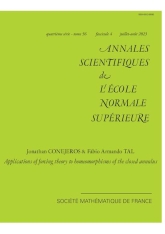Applications de la théorie du forçage aux homéomorphismes de l'anneau compact
Applications of forcing theory to homeomorphisms of the closed annulus

- Consulter un extrait
- Année : 2023
- Fascicule : 4
- Tome : 56
- Format : Électronique
- Langue de l'ouvrage :
Anglais - Class. Math. : 37E30, 37E45
- Pages : 1155-1197
- DOI : 10.24033/asens.2552
Dans cet article, nous étudions les homéomorphismes de l'anneau compact qui sont isotopes à l'identité d'un point de vue de la théorie des rotations, en utilisant la notion de théorie de forçage récemment développée pour les homéomorphismes des surfaces. Notre premier résultat est une solution à la conjecture de Boyland sur l'anneau compact : Supposons que $f$ est un homéomorphisme de $\overline{\mathbb{A}}: = (\mathbb{R} / \mathbb{Z}) \times [0,1]$ qui est isotope à l'identité et qui préserve une mesure borélienne de probabilité $\mu$ à support total. Nous prouvons que si l'ensemble de rotation de $f$ est un intervalle non trivial, le nombre de rotation de la mesure $\mu$ ne peut pas être une borne de cet intervalle. Nous étudions aussi les homéomorphismes $f$ dont $\mathbb{A}: = (\mathbb{R} / \mathbb{Z}) \times (0,1)$ est une région d'instabilité. Nous prouvons que si les nombres de rotation de la restriction de $f$ aux composantes du bord appartiennent à l'intérieur de l'ensemble de rotation de $f$, alors la déviation de $f$ de son ensemble de rotation est uniformément bornée. Enfin en combinant ce dernier résultat et des travaux récents de réalisation de vecteurs de rotation pour les anneaux continus, nous déduisons que si $f$ est un homéomorphisme de $\overline{\mathbb{A}}$ qui est isotope à l'identité et qui préserve l'aire, alors pour tout nombre réel $\rho$ dans l'ensemble de rotation de $f$ il existe un ensemble d'Aubry-Mather, c'est-à-dire un ensemble compact et invariant tel que tout point dans cet ensemble a un nombre de rotation égal à $\rho$. Cela étend un résultat de P. Le Calvez connu auparavant uniquement pour les difféomorphismes.

